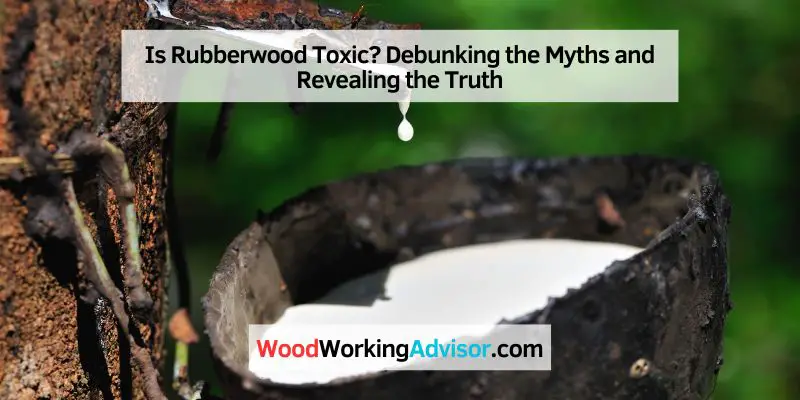Rubberwood is non-toxic and safe for use in furniture and other household items. It poses no health risks to humans.
Now, let’s explore more about rubberwood and its properties. Rubberwood, also known as plantation hardwood, is a sustainable and environmentally friendly choice for furniture and other wooden products. The tree is harvested for its latex sap, which is used to make rubber products.
Once the tree has reached the end of its latex production life, it is then used for wood production, making it a versatile and renewable resource. Rubberwood has gained popularity due to its attractive appearance and durability. It is a dense and sturdy wood, making it suitable for a variety of applications. It is often used in furniture, flooring, and cabinetry. In terms of toxicity, rubberwood is completely safe for use. It does not release any harmful chemicals or toxins into the environment. This makes it a suitable option for homes, especially for those with children or individuals with chemical sensitivities. Furthermore, rubberwood is resistant to decay and fungal growth, ensuring its longevity. It is also resistant to warping and shrinking, making it a reliable choice for furniture that will withstand daily use. Overall, rubberwood is a sustainable, durable, and non-toxic option for furniture and other wooden products, making it a popular choice for environmentally conscious consumers.
The Origins Of Rubberwood
Rubberwood is derived from the rubber tree and is not toxic. It is considered an eco-friendly and sustainable material for furniture and other products. The wood is safe and suitable for indoor use, making it a popular choice for many environmentally conscious consumers.
Rubberwood, also known as parawood, is a type of hardwood that comes from the Hevea brasiliensis tree. This species is native to the Amazon rainforest but is now widely cultivated in countries like Brazil, Malaysia, and Indonesia.
Harvesting Process
When it comes to the harvesting process, the unique characteristic of rubberwood sets it apart from other types of wood. Unlike traditional hardwoods that are felled solely for timber purposes, rubberwood is obtained as a byproduct of the rubber industry.
The process begins with the tapping of the tree for latex, which is used to produce natural rubber. After around 26 to 30 years of latex production, the tree’s productivity decreases. At this point, the tree is considered mature and may no longer be useful in the rubber industry.
Instead of leaving the mature trees to rot or burning them, which would contribute to environmental pollution, these discarded rubberwood trees are harvested for their timber. This sustainable practice gives rubberwood a second life and reduces waste.
Common Uses
Rubberwood is valued for its durability, attractive appearance, and eco-friendly properties. It is commonly used in furniture manufacturing due to its strength and ability to hold fasteners. This type of wood is particularly suitable for furniture pieces that require stability and sturdiness, such as tables, chairs, and cabinets.
In addition to furniture, rubberwood is also utilized in various other applications. Its medium density makes it suitable for constructing items like flooring, veneers, and plywood. Furthermore, rubberwood is often used to make kitchen utensils, cutting boards, and toys due to its non-toxic and food-safe nature.
When considering the multiple uses and eco-friendliness of rubberwood, it is easy to see why it has gained popularity in various industries and households around the world.

The Toxicity Debate
When it comes to considering the potential toxicity of materials used in furniture and home decor, rubberwood often sparks a lively debate among consumers. With conflicting information readily available, it can be challenging to determine whether or not rubberwood is toxic. In this section, we will explore the toxicity debate surrounding rubberwood and separate fact from fiction.
Fact Vs. Fiction
Is rubberwood toxic?
Fact: Rubberwood, also known as parawood, is generally considered non-toxic.
Fiction: Some may claim that rubberwood is toxic, but this belief is often based on misinformation or misunderstandings.
While it is true that some natural wood species can release toxins or allergens, rubberwood is not one of them. Its non-toxic nature makes it a popular choice for various applications, including furniture and kitchenware.
Chemical Composition
Rubberwood is sourced from the Hevea brasiliensis tree, primarily cultivated for latex production. As a deciduous hardwood, rubberwood possesses unique qualities that set it apart from other timber materials.
One noteworthy characteristic is its low level of resin content. Compared to other woods with higher resin content, rubberwood is less likely to release any potentially harmful chemicals into the environment or pose a health risk to humans.
Furniture made from rubberwood often undergoes a drying process to further minimize the resin content. This ensures a safer and more stable end product.
Health And Environmental Impact
Exposure Risks
Rubberwood is generally considered safe and non-toxic. However, when processed, it may release small amounts of formaldehyde, which can cause irritation and respiratory issues in sensitive individuals. Additionally, improper disposal or burning of rubberwood products could release harmful volatile organic compounds into the environment, posing risks to both human and environmental health.
Sustainability Practices
Rubberwood is an eco-friendly choice due to its sustainable harvesting practices. It is derived from rubber trees that have reached the end of their latex-producing life cycle. This promotes sustainable forestry and reduces the demand for cutting down new trees. Moreover, utilizing rubberwood helps to minimize waste and deforestation in traditional timber industries, contributing positively to the environment.
Benefits Of Rubberwood
When it comes to choosing the right type of wood for your furniture, the options can be overwhelming. One popular choice that has gained attention in recent years is rubberwood. Despite its name, rubberwood has nothing to do with rubber. It is actually a type of hardwood that comes from the rubber tree, also known as Hevea brasiliensis. Rubberwood offers several benefits that make it an excellent choice for furniture and other wooden items.
Durability
One of the main advantages of rubberwood is its remarkable durability. This type of wood is known for its high strength and resistance to wear and tear, making it ideal for furniture that is meant to withstand daily use. Whether you have a busy household or you want furniture that will last for many years, rubberwood is a reliable and long-lasting option. Its natural strength also makes it less prone to warping or cracking as compared to other types of wood.
Affordability
If you’re looking for quality furniture without breaking the bank, rubberwood is a budget-friendly option. It is often more affordable than other hardwoods, such as oak or mahogany. Despite its lower price, rubberwood still offers impressive durability and a beautiful natural grain. Its affordability makes it a popular choice for both budget-conscious homeowners and those who appreciate the value it offers.
In addition to its durability and affordability, rubberwood is also known for its eco-friendliness. The rubber tree used to produce rubberwood is harvested once its latex production starts to decline, typically after about 25 years. By utilizing this sustainable resource, rubberwood helps to reduce waste and minimize the negative impact on the environment.
To summarize, rubberwood is a durable and affordable option for furniture and other wooden items. Its strength, resistance to wear and tear, and attractive grain make it a popular choice among homeowners and furniture manufacturers. Additionally, its eco-friendly nature adds to its appeal. Whether you’re furnishing your home or searching for wooden products, choosing rubberwood can be a smart and sustainable choice.
Proper Handling And Care
Proper handling and care are essential when it comes to ensuring the longevity and safety of your rubberwood furniture. By following a few maintenance tips and safety guidelines, you can keep your furniture looking like new and prevent any potential health risks. Let’s delve into these aspects in more detail.
Maintenance Tips
Maintenance of rubberwood furniture is relatively simple and straightforward, requiring minimal effort on your part. Here are some useful tips to help you keep your furniture in excellent condition:
- Regular dusting: Use a soft cloth or feather duster to remove dust from the surface of your rubberwood furniture. This will prevent the build-up of dirt and help maintain its natural shine.
- Avoid direct sunlight: Excessive exposure to sunlight can cause the color of rubberwood to fade over time. Place your furniture away from windows or use curtains and blinds to shield it from direct sunlight.
- Proper cleaning: Wipe spills and stains immediately with a damp cloth. Avoid using harsh chemical cleaners or abrasive materials that can damage the wood’s surface. Instead, opt for mild soap and water.
- Applying furniture polish: To enhance the shine of your rubberwood furniture, you can apply a small amount of furniture polish. Be sure to follow the manufacturer’s instructions and buff the surface gently for a smooth finish.
- Regular inspections: Periodically inspect your furniture for any signs of damage or wear. This allows you to address any issues promptly and prevent them from worsening.
Safety Guidelines
While rubberwood is generally considered safe for use in furniture production, it’s important to adhere to some safety guidelines to minimize any potential risks:
- Avoid exposure to water: Rubberwood is susceptible to damage when exposed to excessive moisture. Keep your furniture away from areas prone to high humidity or spills.
- Adequate ventilation: Proper air circulation is crucial to prevent the accumulation of moisture around your rubberwood furniture. Ensure that the room is well-ventilated, especially in humid environments.
- Use coasters and placemats: When placing hot or cold objects on your rubberwood furniture, use coasters or placemats to protect the surface from potential damage.
- Lifting and moving: When relocating your furniture, lift it instead of dragging it across the floor. This helps prevent scratches or other forms of damage.
- Avoid sharp objects: Keep sharp objects, such as knives or scissors, away from your rubberwood furniture to prevent accidental cuts or scratches.
By adhering to these maintenance tips and safety guidelines, you can ensure that your rubberwood furniture remains in excellent condition and safe for use. Taking a few precautions and investing a little time in regular care can go a long way in preserving the beauty and durability of your furniture.

Credit: issuu.com
Frequently Asked Questions Of Is Rubberwood Toxic
What Is The Problem With Rubberwood?
The problem with rubberwood is that it is not very durable and prone to scratches and dents. Additionally, it can be susceptible to moisture and can warp or crack over time. It is also not as aesthetically pleasing as other types of wood and may require frequent maintenance to keep it looking good.
Does Rubberwood Have Formaldehyde?
Rubberwood does not inherently contain formaldehyde, but the presence of the chemical depends on the finishing materials used. The use of low VOC (volatile organic compounds) finishes can minimize or eliminate formaldehyde emissions.
Does Rubber Wood Offgas?
Yes, rubber wood off-gases, but it is minimal and decreases over time. It’s safe for indoor use.
Why Is Rubberwood So Cheap?
Rubberwood is inexpensive due to its abundance and fast growth, making it widely available. Its affordability stems from its use in large-scale furniture production, where it can be sourced from sustainably managed plantations.
Conclusion
While rubberwood may contain toxic elements, its use in furniture is generally safe. It’s crucial to verify the source and treatment of rubberwood products to avoid potential risks. Understanding the potential toxicity of rubberwood can help consumers make informed decisions about their purchases and promote safer practices in the furniture industry.


